Monumental. That’s what Peking can be, and frequently is. There were at least three monuments we saw the last few days. Starting from the newest:

The Olympic Village and stadia. No doubt, as I mentioned, Beijing is ready to welcome the Olympics, and you’ll be seeing a lot of what I saw, and hearing what I heard this a.m. (at 4 a.m. Professor Park and I left our hotel for a cab ride in to Tiananmen Square for the flag raising; you can recognize me from the pictures–I’m the one without a cigarette, that is, if you can find me amid the 4000 people there for the 5:06 flag raising and the national anthem, QiLai, which means “Arise‚” or, at 5 a.m., “awake!”)
The Olympics dominate almost everything–the vendors everywhere (I think the Beijing city government owns the copyright, so there’s little intellectual property theft), the only English language TV station (the torch was up on Mt. Everest today, and there’s a special postal cancel at 20,000 feet! I’m not going up there to get it!), and the billboards. As I viewed the stadium from the bus (which was crawling on the expressway near it), I thought–another monumental project with one million people working on it.
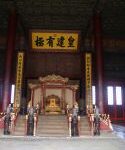 Just like the other two monuments we visited the last
Just like the other two monuments we visited the last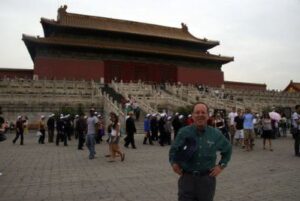 two days. One was the Forbidden City, home of the Ming and Qing Emperors since the late 15th century, when the 3rd Ming emperor moved his capital north (so he could better control the barbarians, as I recall).
two days. One was the Forbidden City, home of the Ming and Qing Emperors since the late 15th century, when the 3rd Ming emperor moved his capital north (so he could better control the barbarians, as I recall).
No matter how often I’ve been here, I’m still in awe of the 9,999 rooms that 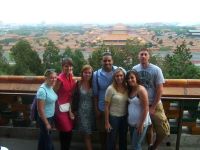 it has, only a small portion of which are open to the public. The last emperor lived here in 1908, was dethroned in 1911, but lived in parts of the city until 1924, when he was evicted and went to live in the Japanese concession in Tientsin, then became the first and last emperor of Manchukuo in the 1930s, then was a gardener after spending some time as a guest of the PRC in jail.
it has, only a small portion of which are open to the public. The last emperor lived here in 1908, was dethroned in 1911, but lived in parts of the city until 1924, when he was evicted and went to live in the Japanese concession in Tientsin, then became the first and last emperor of Manchukuo in the 1930s, then was a gardener after spending some time as a guest of the PRC in jail.
Anyway, like so much around here, it’s brushed up, the Starbucks evicted, bolstered by fresh paint and huge crowds. There were probably more people in the city yesterday than were in it during most of the entire reigns of the emperors. It’s laid out north to south, with the private quarters toward the north. The best part of the visit for me has always been the trek up Coal Hill, 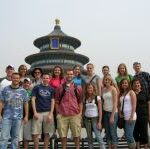 which overlooks the Forbidden City. The 1 million people who built it, built a moat and piled the dirt at the north end for an imperial park.
which overlooks the Forbidden City. The 1 million people who built it, built a moat and piled the dirt at the north end for an imperial park.
North of Coal Hill there’s an interesting place, too–it’s the Normal University, but in 1919 was the site of the origins of the May 4th movement, a student led protest against the Allies’ conceding of the Shantung peninsula to Japan as one of the fruits of the First World War. The uproar led, among other things, to the origination of the Chinese Communist Party. Ironically, when the communists came to power, one of the first things they did was to move the students to the former Christian college (Yenching University) on the outskirts of town.

The final monument was the Great Wall, another treat, no matter how many times you’ve seen it. It boggles the imagination to think that the first emperor (Qin, whose tomb we’ll visit tomorrow in Xian) solidified the 3,000-mile wall, which stretches from the Gulf of Chili into the Gobi desert. The part we went to is the closest to Beijing, about 40 miles away, is at an elevation of 2,500 feet (my GPS sometimes comes in handy). We took a cable car with the other “balloons‚” (it was raining and
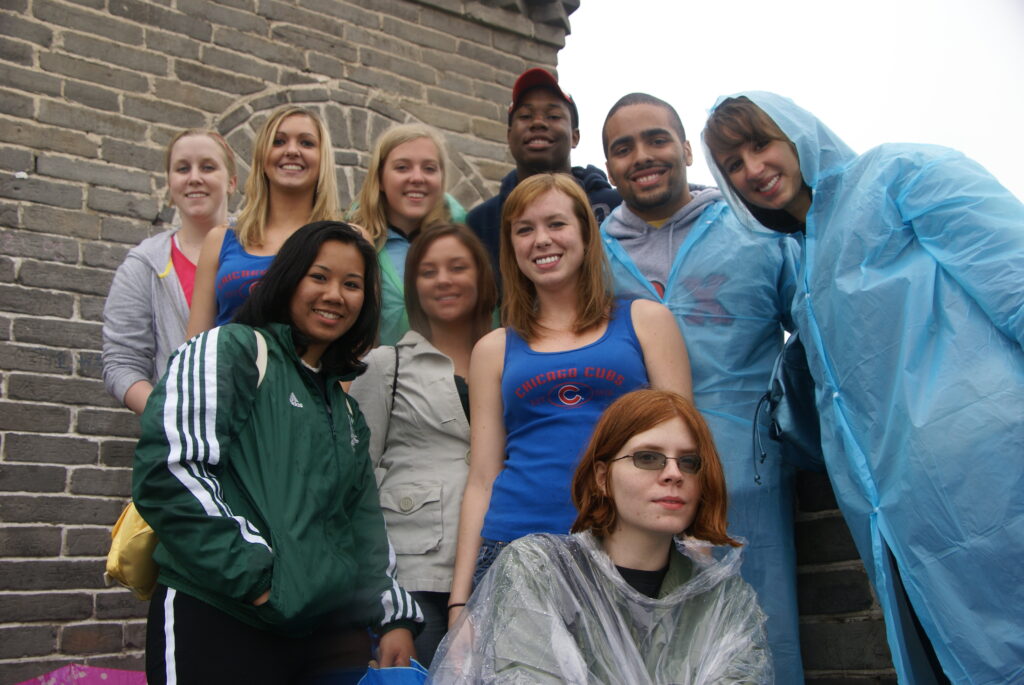
people bought colorful ponchos) and walked for about two hours. The wall, incidentally, can’t be seen from the moon (despite what they say) and never kept anyone out, but probably kept the Chinese in. I liked it better in January, when I did not have to share it with crowds (they say when you’re one in a million, in China there are 1,500 others just like you)!
A word on our one business visit. We went to Caterpillar Beijing, which was neat because they had heard of Illinois Wesleyan. We had an American expat, who has spent time at Cat Europe as well, talk about an hour on the history of Cat in China. It’s been here since the late 1970s, and is still trying to establish a presence. Although Cat for the first time earned more overseas than in the United States, Cat’s sales here are only about $1 billion. Sounds like a lot, and I wish I had it, but it’s only about the same as the amount Cat earns on licensing (it gets money for letting people sell Caterpillar shoes!) Nonetheless, the company has moved its Asia Pacific headquarters to Beijing (from Tokyo) and has put China into its strategic plan as a critical factor in the company’s success. It’s a premium brand though, in a largely price market, so Cat has done some unusual things here: developed independent financing, started rental stores, and is manufacturing world-class quality equipment in China. Wanna buy a wheel loader anyone? People here probably do. China is like I-55–under construction.
We have a long day today of sightseeing (a tour of the hutongs, the older neighborhoods, on bicycle), then the overnight train to Xi’an, nearly 600 miles away (I’ll check my GPS) and I think 10 or 11 hours on a sleeper. That was the capital of China for a thousand years, most recently a thousand years ago! Now that’s a lot of history!
Have a great weekend.